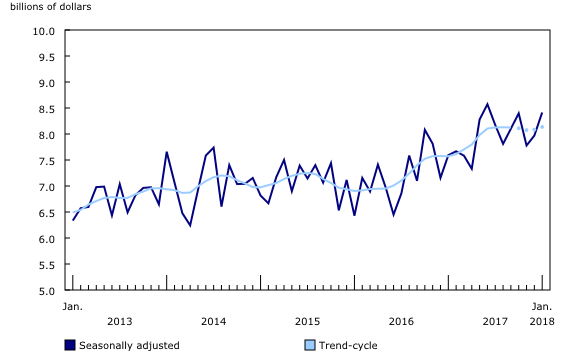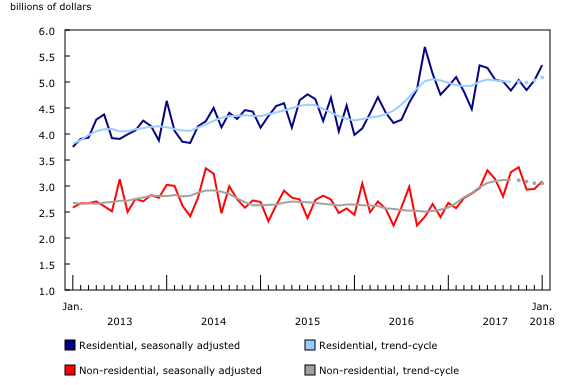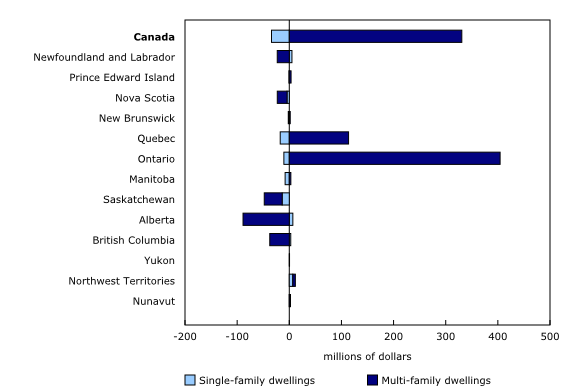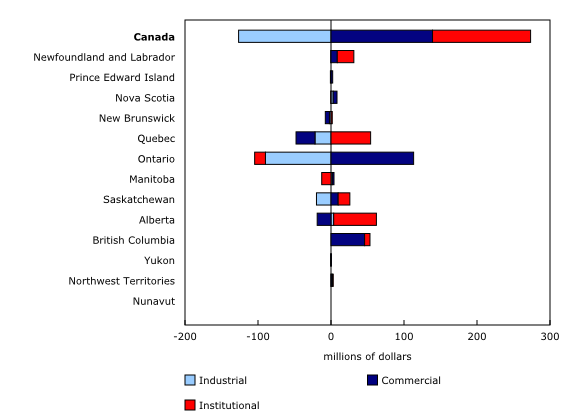Building permits, January 2018
Archived Content
Information identified as archived is provided for reference, research or recordkeeping purposes. It is not subject to the Government of Canada Web Standards and has not been altered or updated since it was archived. Please "contact us" to request a format other than those available.
Released: 2018-03-08
$8.4 billion
January 2018
5.6% 
(monthly change)
$70.6 million
January 2018
22.9% 
(monthly change)
$25.8 million
January 2018
20.9% 
(monthly change)
$104.1 million
January 2018
-12.7% 
(monthly change)
$78.3 million
January 2018
-7.4% 
(monthly change)
$1,601.5 million
January 2018
6.9% 
(monthly change)
$3,458.9 million
January 2018
13.2% 
(monthly change)
$231.3 million
January 2018
-5.6% 
(monthly change)
$190.9 million
January 2018
-18.0% 
(monthly change)
$1,091.8 million
January 2018
-3.4% 
(monthly change)
$1,534.8 million
January 2018
1.2% 
(monthly change)
$2.8 million
January 2018
17.0% 
(monthly change)
$20.7 million
January 2018
245.1% 
(monthly change)
$2.3 million
January 2018
...%
(monthly change)
Canadian municipalities issued $8.4 billion in building permits in January, up 5.6% following a 2.5% rise in December. The value of permits for three components rose, while industrial buildings (-18.6%) and single-family dwellings (-1.3%) declined. The January increase was largely due to higher construction intentions for multi-family dwellings in Ontario.
Value of permits rebounds for multi-family dwellings in Ontario
The value of permits for multi-family dwellings in Ontario rose 71.0% (+$404.3 million) to $974.0 million in January, more than offsetting the 39.7% decline (-$374.7 million) reported the previous month. Nationally, apartments accounted for approximately three-quarters of the value of permits for multi-family dwellings in January, while row houses made up just under 18%. The rest of the multi-family dwelling component is comprised of permits for doubles such as semi-detached homes, and minor residential additions and renovations (permits under $50,000).
Toronto leads the gains among census metropolitan areas
In January, 16 of the 36 census metropolitan areas (CMAs) reported gains, led by Toronto. The total value of permits reported by municipalities in Toronto increased 25.5% to $1.8 billion in January, following a 14.0% decline in December. The increase mainly stemmed from multi-family dwellings, which hit $590.3 million in January, bouncing back from $311.0 million in December, the lowest point in 2017. The second largest gain was reported in the CMA of London, up 89.3% (+$77.5 million) from December, also due to multi-family dwellings.
New this month in the Building Permits Survey
Starting with this release, Statistics Canada will be publishing unadjusted data by type of structure and type of work. Each building permit submitted has an identified type of structure and type of work approved for construction. For example, a permit could be issued for an improvement (type of work) to an existing hotel (type of structure). There are six main types of work: new residential and non-residential construction, improvements, conversions, deconversions, garage and carports, and in-ground swimming pools.
The value of permits for new construction was $4.5 billion in January, followed by improvements ($1.7 billion), conversions ($69.5 million), garage and carports ($21.9 million), in-ground swimming pools ($3.4 million) and deconversions ($2.8 million).
In order to be considered a permit for a conversion, one or more residential dwelling units need to be created from an existing structure. Alternately, deconversions need to have one or more residential dwelling units removed. In January, 14,836 dwelling units were created of which 1,016 were created through conversions, while 77 units were lost due to deconversions.
Permits for improvements (renovations and alterations) totalled $1.7 billion in January. Improvements accounted for about 60% of the total value of building permits in the non-residential sector in January, compared with a little over 8% of the total permit value for residential buildings.
Note to readers
Unless otherwise stated, this release presents seasonally adjusted data, which facilitates month-to-month comparisons by removing the effects of seasonal variations. For information on seasonal adjustment, see Seasonally adjusted data – Frequently asked questions.
Starting with the January 2018 reference month (March 8 release), several changes were made to the Building Permits Program as a result of moving to a new processing system, the Integrated Business Statistics Program. You can read more about this program on the Statistics Canada web site using this hyperlink.
Here is a summary of the changes introduced:
- Concept change: Previously, the type of structure ''cottage'' was coded as ''Single house'' if the value of the permit was higher than $50,000. As of the January 2018 reference month, all cottages will remain as that type of structure regardless of the permit value.
- Merging existing CANSIM tables: CANSIM tables 026-0001 to 026-0008 and 026-0010 will be archived for historical data and merged into a new table (CANSIM table 026-0021), which will include data by type of structure and type of work, starting with the January 2018 reference month.
- Cancelling publication 64-001-x.pdf: The information that is currently in this publication will be available in the new CANSIM table 026-0021. Consequently, this product has been discontinued.
Preliminary analysis found that these changes do not create any notable breaks in the series, and that the data remain comparable over time.
The seasonally unadjusted data for January 2011 to December 2017 will not be available in the new table (CANSIM #26-0021) until March 12. However, in the interim, these data are available in CANSIM tables 26-0001 to 26-0008 and 26-0010.
The Building Permits Survey covers over 2,400 municipalities, representing 95% of the Canadian population. The communities representing the other 5% of the population are very small and their levels of building activity have little impact on the total for the entire population.
Building permits data are used as a leading indicator of activity in the construction industry.
The value of planned construction activities presented in this release excludes engineering projects (such as waterworks, sewers or culverts) and land.
For the purposes of this release, the census metropolitan area of Ottawa–Gatineau (Ontario/Quebec) is divided into two areas: the Ottawa part and the Gatineau part.
Unless otherwise specified, the highlights refer to seasonally adjusted current dollars and are ranked in terms of dollar change rather than percentage change.
Building components
Single-family dwellings: Residential buildings containing only one dwelling unit (for example, single-detached house, bungalow, linked home (linked at the foundation)).
Multi-family dwellings: Residential buildings containing multiple dwelling units (for example, apartment, apartment condominium, row house, semi-detached).
Industrial buildings: Buildings used in the transformation of goods or related to transportation and communication.
Commercial buildings: Buildings used in trade or distribution of goods and services.
Institutional and government buildings: Buildings used to house public and semi-public services such as those related to health and welfare, education, or public administration, as well as buildings used for religious services.
Revision
Data for the current reference month are subject to revision based on late responses. Data for the previous month have been revised.
Trend-cycle estimates have been added to the charts as a complement to the seasonally adjusted series. Both the seasonally adjusted and the trend-cycle estimates are subject to revision as additional observations become available. These revisions could be large and even lead to a reversal of movement, especially at the end of the series. The higher variability associated with the trend-cycle estimates is indicated with a dotted line on the chart.
For information on trend-cycle data, see the StatCan Blog and Trend-cycle estimates – Frequently asked questions.
Next release
Data for February on building permits will be released on April 10.
Contact information
For more information, or to enquire about the concepts, methods or data quality of this release, contact us (toll-free 1-800-263-1136; 514-283-8300; STATCAN.infostats-infostats.STATCAN@canada.ca) or Media Relations (613-951-4636; STATCAN.mediahotline-ligneinfomedias.STATCAN@canada.ca).
- Date modified:





